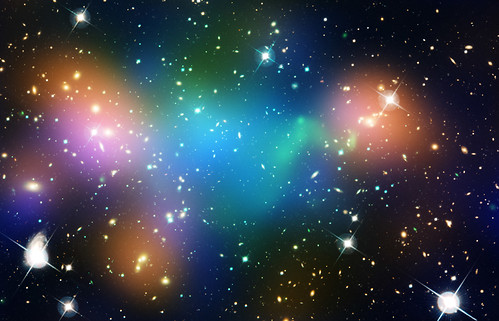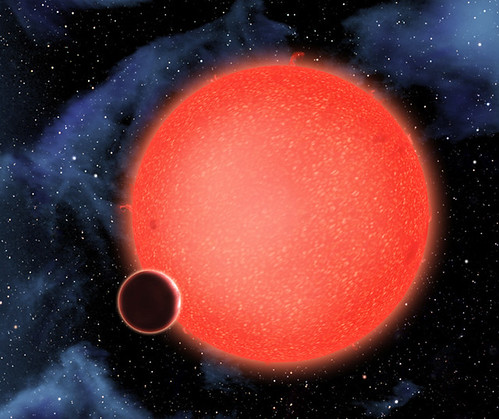Awesomeness Round-Up – 3/5/2012
- By Maggie Masetti
- March 5, 2012
- 2 Comments

Credit: NASA, ESA, CFHT, CXO, M.J. Jee (University of California, Davis), and A. Mahdavi (San Francisco State University)
Astronomers have observed what appears to be a clump of dark matter left behind from a wreck between massive clusters of galaxies. The result could challenge current theories about dark matter.
The above image shows the distribution of dark matter, galaxies, and hot gas in the core Abell 520, a merging galaxy cluster formed by violent collision. It is a composite of data from several sources. The natural-color image of the galaxies is from the Hubble Space Telescope and the Canada-France-Hawaii Telescope in Hawaii. Superimposed on it are false-color maps showing the concentration of starlight, hot gas, and dark matter in the cluster.
Starlight from galaxies, derived from observations by the Canada-France-Hawaii Telescope, is colored orange. The green-tinted regions show hot gas, as detected by the Chandra X-ray Observatory. The gas is evidence that a collision took place. The blue-colored areas pinpoint the location of most of the mass in the cluster, which is dominated by dark matter. Dark matter is an invisible substance that makes up most of the universe’s mass. The dark-matter map was derived from the Hubble Wide Field Planetary Camera 2 observations, by detecting how light from distant objects is distorted by the cluster galaxies, an effect called gravitational lensing.
The blend of blue and green in the center of the image reveals that a clump of dark matter resides near most of the hot gas, where very few galaxies are found. This could present a challenge to basic theories of dark matter, which predict that galaxies should be anchored to dark matter, even during the shock of a collision.
You can read more at the news release.
Here’s a really cool video called “Temporal Distortion,” shot by Randy Halverson. (And featuring an original score by Bear McCreary of Battlestar Galactica fame, which is also awesome.)
In the caption, Halverson says, “What you see is real, but you can’t see it this way with the naked eye. It is the result of thousands of 20-30 second exposures, edited together to produce the timelapse. This allows you to see the Milky Way, Aurora and other Phenomena, in a way you wouldn’t normally see them.”
One of the cool things he caught is a meteor with a persistent train (see it at :53 and 2:17 into the video). Phil Plait actually wrote a blog entry about it, which is definitely worth reading.

Credit: NASA/JPL-Caltech
Astronomers using the Spitzer Space Telescope have discovered solid buckyballs in space. Buckyballs were detected definitively in space for the first time by Spitzer in 2010, but they were gaseous molecules.
What are buckyballs? They are molecules made up of 60 carbon atoms arranged in a hollow sphere, much like a soccer ball. Because of their resemblance to the geodesic domes of architech Buckminster Fuller, they were named buckminsterfullerene, or buckyballs. Their unusual structure makes them ideal candidates for electrical and chemical applications on Earth, including superconducting materials, medicines, water purification and armor.
This latest discovery was made by scientists using Spitzer to detect tiny specks of matter, or particles, consisting of stacked buckyballs. They found the particles around a pair of stars called “XX Ophiuchi,” 6,500 light-years from Earth, and detected enough to fill the equivalent in volume to 10,000 Mount Everests.
“This exciting result suggests that buckyballs are even more widespread in space than the earlier Spitzer results showed,” said Mike Werner, project scientist for Spitzer at NASA’s Jet Propulsion Laboratory in Pasadena, Calif. “They may be an important form of carbon, an essential building block for life, throughout the cosmos.”
Read more at the NASA release.
Astronomers using NASA’s Chandra X-ray Observatory have clocked the fastest wind yet discovered blowing off a disk around a stellar-mass black hole. The record-breaking wind is moving about 20 million mph, or about 3 percent of the speed of light. This is nearly 10 times faster than had ever been seen from a stellar-mass black hole. This result has important implications for understanding how this type of black hole behaves.
“This is like the cosmic equivalent of winds from a category five hurricane,” said Ashley King from the University of Michigan, lead author of the study published in the Feb. 20 issue of The Astrophysical Journal Letters. “We weren’t expecting to see such powerful winds from a black hole like this.”
Read more in the NASA feature.

Credit: NASA/CXC/M.Weiss

Credit: NASA, ESA, and D. Aguilar (Harvard-Smithsonian Center for Astrophysics)
New planet alert! A “waterworld” was just discovered using the Hubble Space Telescope. GJ1214b, shown in this artist’s view, is a super-Earth orbiting a red dwarf star some 40 light-years from Earth. The planet is also enshrouded by a thick, steamy atmosphere. GJ1214b represents a new type of planet, like nothing seen in our solar system or any other planetary system currently known. Like we said in our blog about the bizarre newly discovered solar systems presented at the AAS meeting, if it’s not physically impossible, it’s out there somewhere!.
GJ1214b was discovered by the ground-based MEarth Project in 2009. You can read the full release on the Space Telescope site.



I have read your post. In here you said “The blend of blue and green in the center of the image reveals that a clump of dark matter resides near most of the hot gas, where very few galaxies are found. This could present a challenge to basic theories of dark matter, which predict that galaxies should be anchored to dark matter, even during the shock of a collision.” I just think in my head, why scientist has assumption galaxies should be anchored to dark matter? Are there someone explain it to me?
Ibnu – We’ll see if we can get a post up sometime soon about dark matter! It’s interesting stuff, and perhaps we could shed some light on your question.